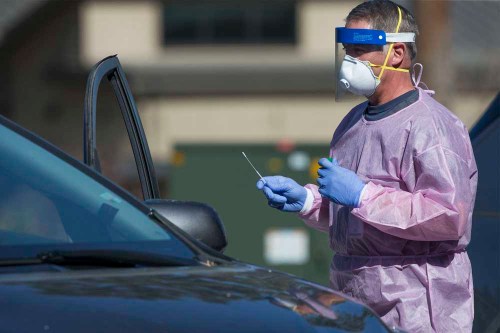Oregon fails to test enough residents for coronavirus as need hits all-time high
Published 7:00 am Monday, November 16, 2020

- A health care worker conducts COVID-19 testing in April 2020 in Bend.
SALEM — The number of Oregonians tested for coronavirus has barely budged amid a record-setting wave of infections, with health care systems and state officials failing to deliver at the time of greatest need.
Roughly 45,000 Oregonians were tested the first week of November, according to preliminary state data.
That’s barely more than the summer peak in July.
The difference now? More than 2½ times as many people are actively infected, cases are rising exponentially and Gov. Kate Brown is so concerned she just issued a partial lockdown.
Public health experts say Oregon’s inadequate rate of coronavirus testing means a large number of cases have and continue to silently spread across the state, seeding new infections.
To be sure, few U.S. states are testing enough of their residents to effectively contain the highly contagious coronavirus as it shatters records and infects as many as 180,000 people a day.
But state officials and health care providers had more than eight months to prepare for this moment.
Early in the pandemic they faulted the federal government for testing shortfalls, but that is no longer fully the case. On top of existing test capacity that local hospitals have built over subsequent months, the Trump administration is now shipping tens of thousands of rapid antigen tests to Oregon each week through year’s end — something state officials pledged would nearly double testing capacity.
And yet, significantly more Oregonians still aren’t being tested as a result.
That has left many exasperated and searching for answers.
“The state has never seemed to be able to get to sufficient testing on any level compared to the rest of the country for inexplicable reasons,” said Multnomah County Commissioner Sharon Meieran, who also is an emergency room doctor.
Compared to four months ago, Oregon has increased the number of people tested each week by just 10%, according to state statistics. States across the nation have upped their testing numbers by an average 58% in the same period, according to data from the COVID Tracking Project.
Meieran said she understands expanding testing “is a complex issue” but is baffled why Oregon does not appear to have similar gains.
“I have been asking this question for seven months now and have never gotten what I feel like is a solid answer,” she said.
Testing supplies, it seems, are no longer Oregon’s largest stumbling block. Among other things, the state has instead struggled to secure enough health care workers to oversee expanded test collections.
Dr. Melissa Sutton, who monitors testing capacity for the Oregon Health Authority, said she believes it’s misleading to compare the state’s numbers to the nation’s because of the way some calculations are made.
But she acknowledged the state would benefit enormously from testing more Oregonians and said it has been slowed by “bottlenecks” in the system. Those include a limited pool of health care providers authorized to administer testing, not enough staffing and challenges deciding where to offer events, such as at pop-up sites or in the emergency room.
“But I think what we’re seeing is health care systems doing everything they can to increase the number of COVID-19 tests that they’re offering,” Sutton said. “Honestly, it takes time to build these systems to collect additional tests.”
State officials recognized early that those challenges would exist, however.
Asked what steps have been taken to increase staffing for test collections since the federal government began supplying at least 60,000 tests a week in October, Sutton said efforts are ongoing.
“We are in dialogue with those partners about the barriers and opportunities they see and are both helping them to adjust and in turn adjusting our own strategies and tactics,” Sutton wrote in an email.
“Like everything in this pandemic, the steep increase in test availability was unprecedented and so we are both building the network as we are deploying the tests to that network.”
There’s certainly demand among Oregonians for testing. The state has reported an average of 900 new coronavirus cases a day over the past week, and those account for only the infections that are known.
Oregon’s testing woes have long been known, but there’s no escaping the challenge now.
Early in the pandemic, state leaders said they weren’t able to get the testing kits and supplies needed because the federal government prioritized shipments to other states with more COVID-19 cases.
Even the federal government acknowledged Oregon’s obstacles. Dr. Deborah Birx, the White House coronavirus response coordinator, called Oregon out in April as one of “three states that we’re working on building capacity in.”
State officials tried to boost testing capacity on their own.
By summer, their efforts seemed to be paying off. The state reported a record 41,300 Oregonians had been tested one week in mid-July, in conjunction with the summer wave of infections.
Among those screened, a record 2,213 Oregonians also tested positive for coronavirus that week.
The positivity rate — the number of people testing positive divided by the number of people screened — was about 6%.
State officials remained upbeat, believing they were testing adequately.
While that rate held through much of summer, it spiked in mid-October and has now reached double digits.
Just 45,405 Oregonians secured tests the first week of November, according to preliminary data that still may tick up a bit.
An eye-popping 5,433 Oregonians tested positive — equaling a 12% positivity rate.
Sutton, the Oregon Health Authority senior health advisor, said the rapidly rising positivity rate this fall shows the state clearly isn’t testing enough anymore.
“As this surge has begun, I think we’ve all been shocked at how quickly that figure has changed,” Sutton said. “This surge is really straining our system in many ways, and it’s certainly straining our ability to test quickly.”
While officials acknowledge the need to test more now, they take issue with other metrics that have consistently suggested Oregon lags nearly every other state.
Data from two of the most prominent test tracking sites, the COVID Tracking Project and the Johns Hopkins Coronavirus Resource Center, shows that Oregon ranks 49th or 50th among U.S. states for the amount of coronavirus testing it offers per capita.
But Sutton said that because many other states report total tests given, and not total people tested, it’s “an apples to oranges” comparison.
In Oregon, for example, someone in a long-term care facility might be tested multiple times in a given month.
Oregon would count it once, while another state would count each test.
Sutton said state officials don’t publicly share the number of tests administered because they aren’t entirely sure the numbers are accurate, due to how results are reported by laboratories and health systems.
Even so, she believes the number of tests administered in the past month has actually increased by about 50%, because the state is testing more people multiple times.
Sutton said she believes Oregon’s testing performance is more “middle of the pack.”
Restrictive testing guidance still appears to be holding some people back from getting tested.
The Oregon Health Authority generally recommends testing only people with symptoms or people who’ve come in close contact with someone known to have the virus. A few others, such as minorities and migrant agricultural workers, also are given the green light for tests from state public health officials.
In other states it’s not that difficult.
Washington state, for example, allows “(a)nyone who’s concerned about their health” to go get a test.
This article was originally published by The Oregonian/OregonLive, one of more than a dozen news organizations throughout the state sharing their coverage of the novel coronavirus outbreak to help inform Oregonians about this evolving heath issue.









